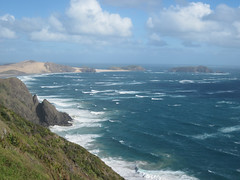While waiting for a ferry to cross the Hokianga Harbor, we strolled the tiny harbor village of Rawene, fringed by mangrove trees that grow in sea mud. The locals use the mangrove leaves, which are loaded with salt, to smoke their fish.
A pickup attached to a trailer of five caged dogs caught my attention. I chatted up with the owner, a guy named Joe. He was heading into the Northland bush to hunt wild pigs with his nephews and brother, and was eager to share his story.
As a pack, the dogs scent the pig and chase them out from under wild scrub inaccessible to the hunters. Joe told me that each dog is bred and trained for specialized tasks. Quicker at avoiding the tusks, his smaller dogs are trained as bailing dogs for holding the pigs with in-the-face barking. His larger dogs are holders, trained to grab the pig’s ear, tail or testicles, or anything they can bite, until the hunters arrive on the scene.
Pig hunting is risky business, he said. It involves wielding a knife, sometimes a gun, while diving into a frenzied pack of biting dogs and 200-pound pigs. Jeeeeez! His dogs are often injured when speared by boar’s tusks which can be as long as four inches. But without the dogs, he said wild pig hunting would be impossible, and “the dogs love it more than life itself.”
 Eager to jumpstart a source of meat for future explorations, Captain James Cook released pigs into the NZ bush, where they thrived. So much so that in the 1930s a government bounty paid ‘two bob a snout’ and during the 1940s each pig tail earned a shilling, or three rounds of ammunition.
Eager to jumpstart a source of meat for future explorations, Captain James Cook released pigs into the NZ bush, where they thrived. So much so that in the 1930s a government bounty paid ‘two bob a snout’ and during the 1940s each pig tail earned a shilling, or three rounds of ammunition.
Joe told me that hunting keeps feral pig populations from getting out of hand, but the Maori are mindful of restricting their take for fear of endangering this prized meat. Whatever he “harvests” he shares with family and friends. Wild pork relished is by the Maori for hangi (meal cooked on hot stones in a pit).
I thought our conversation ended when the ferry arrived, and we headed for the car to load. But a few minutes later, Joe knocked at my car window. He wanted to give me a little something—a chunk of kauri gum. He finds it when hunting in the bush, which overlays ancient buried kauri forests.
Kauri gum oozes through cracks in the tree bark, hardening like resin when exposed to air. Dubbed New Zealand amber, it polishes up to beautiful translucent yellow-gold used for jewelry and other cultural treasures that I’ve seen in museums and shops across the country.
 Maori and Europeans began digging for kauri gum, once they’d collected what they could from the top of the ground. Northland soils were studded with the golden globs from giant kauri over thousands of years old. At one time, gum digging was a major export business, attracting hoards of prospectors, estimated at more than 20,000 during the 19th century. But like NZ gold mining, it was too tough a way to make a living.
Maori and Europeans began digging for kauri gum, once they’d collected what they could from the top of the ground. Northland soils were studded with the golden globs from giant kauri over thousands of years old. At one time, gum digging was a major export business, attracting hoards of prospectors, estimated at more than 20,000 during the 19th century. But like NZ gold mining, it was too tough a way to make a living.
I will always treasure this chance encounter. Joe’s typical of Maori people we’ve met—generous, friendly, so willing to share their customs and a bit of NZ history with Idaho Kiwis. Ufta … I’m getting choked up again. Time to end this post.
Continue Northland: Cape Reinga and Ninety-Mile Beach




